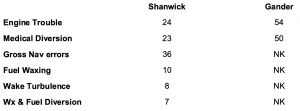38TH ANNUAL CONFERENCE, Santiago, Chile, 15-19 March 1999WP No. 91The Use of Non-flight Plannable Levels in the Nat Region for Contingency |
Introduction
Within the North Atlantic Area (NAT) the introduction of reduced separation standards has raised awareness of the need to re-evaluate “In Flight Contingency Procedures”.
It has been 15 years since a review of the “In Flight Contingency Procedures” has taken place.
The increased traffic levels and the introduction of specific navigational accuracy and aircraft specification including the use of TCAS has highlighted a need for a review.
Discussion
With an increasing aircraft population in the NAT region there has been a corresponding increase in percentage of incidents meaning that there are now more incidents occurring.
IFATCA has concern that with the introduction of reduced vertical and in the near future reduced lateral and horizontal separations, that there is no where an aircraft can transit without compromising safety.
The number of such incidents which require some change in flight profile and which would benefit from a non-flight plannable level are detailed below, however this list does not include flying within RVSM airspace without approval; Instrument failure; level busts.
In 1997 there was :

Within Shanwick in 1998 there has been a comparable number of incidents of the type above up to 27th September.
NOTE: these figures are only for the Shanwick and Gander area of the North Atlantic for which figures were available and must be viewed as a percentage of the whole area on the NAT which includes Iceland, Santa Maria, New York and Bodo.
Most of the above required the aircraft to depart from the original clearance and either 1) carry out a NAT in-flight contingency or 2) request a re-clearance from the appropriate controlling ATC Unit.
In case 1), These instructions advise the crew to establish 30nm from the original track, at an intermediate level e.g. FL345, then divert on a reciprocal track. This part of the procedure is well tried and tested and, as there is 60nm between tracks, is considered safe and appropriate.
It is very unusual for an aircraft involved in an incident as previously described flying within the NAT structure to request and be given, some semblance of a re-clearance to a diversion airfield without emergency separation being used. In fact a controller cannot issue a clearance that is less than the prescribed minima unless prior instructions to that fact have been published.
In the case of a fuel shortage or medical diversion or engine problem where a more direct route across the tracks is required this procedure under conditions of RVSM is not acceptable. In addition to the initial problem the pilot may be faced with additional problems such as RA’s when weaving through a track system at 500’ intervals.
Presently should an aircraft be in the middle of a five or six track system and has to divert, causing that aircraft to cross three or four tracks, the first acceptable level offering least conflictions would be FL 285. At this level the aircraft would be out with the NAT tracks and divorced from the main density of traffic. However this may not be acceptable as an optimum level for the flight.
There is therefore a requirement for a level which is non- flight plannable and which would be used for contingency purposes. This would be a level , known to aircrew and controllers to be used under exceptional circumstances.
Conclusion
There is evidence that there is an identifiable number of incidents which require an aircraft to divert or for ATC to intervene which does not require a descent out of the NAT track structure.
There is a need for a non-flight plannable level to be available which is within the track structure e.g. FL300 to which an aircraft can go in an incident and to which ATC can clear to which provides a safe, expeditious and relatively fuel efficient route to alternate destination.
There is a need for the NATSPG to review the contingency procedures for the NAT and to give consideration to the provision of a non-flight plannable level for contingency purposes.
It is recommended that:
Within the NAT region where RVSM is in operation, FL 300 would be established as a non-flight plannable level as part of the “in-flight emergency contingency” procedures as they apply to the Organised Track System.
Last Update: September 28, 2020
